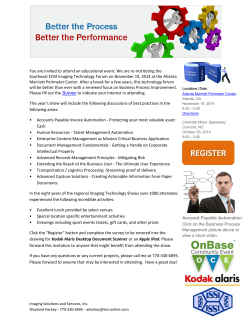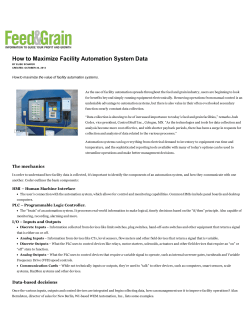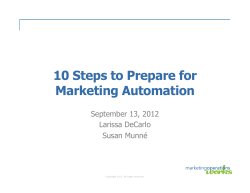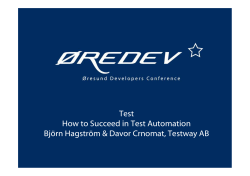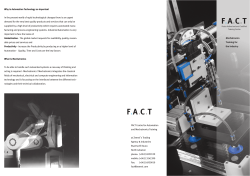
Increasing Invoice Volume Challenges Accounts Payable Departments,
FOR IMMEDIATE RELEASE CONTACT: Diane Sears The Institute of Financial Operations 407-351-3322 diane.sears@financialops.org Increasing Invoice Volume Challenges Accounts Payable Departments, Which Still Rely Largely on Paper Rather than Automation, Study Shows 2014 AP Automation Study by The Institute of Financial Operations explores why some organizations have not adopted latest technology Orlando, Fla. (October 14, 2014) – Accounts payable operations are seeing their invoice volumes increase, signaling improvements in revenue, but they’re not celebrating just yet. That’s because they’re bogged down in manual, paper-based processes instead of taking full advantage of automation. Those are among the findings of the 2014 AP Automation Study by The Institute of Financial Operations, which surveys accounts payable professionals internationally every year about the use of the latest forms of technology. “AP professionals are being called on to do more cash management analysis and financial predictions than ever before, but they’re still handling the basic fundamentals of the job with manual tools,” said Ken Brown, the IFO’s executive director. “The good news is that executives at the highest level are becoming more aware of the efficiencies automation can bring to the process.” Only about 9 percent of respondents reported that their operations are highly automated, which the study defined as receiving less than 10 percent of their invoices on paper. Three times as many (29 percent) said paper accounts for more than 90 percent of the invoices they receive. Among other key findings of the study: • Checks remain the most common payment method in business-to-business transactions, accounting for 50 percent of payments among the organizations of survey respondents — about the same percentage reported in the 2013 study. 1 • Electronic invoicing is keeping costs down. Of respondents who use this form of payment technology, 43 percent said their average e-invoice cost is less than $2, compared with 19 percent who have been able to keep their cost that low processing paper invoices. • As the use of new technology grows, respondents are seeing decreases in error rates in their invoice entry and payment processes. About 40 percent cited decreases for 2014, compared with 30.9 percent a year ago. • The process of data entry, validation, and approval for incoming invoices is taking less time. About 72 percent of respondents said it takes them five days or fewer. In fact, 10 percent reported it takes them less than a day, and 9 percent said it takes less than an hour. • Optical-character recognition (OCR) technology is gaining ground. The survey shows an increase in its use to 38 percent, compared with 23 percent a year ago. • The use of front-end scanning to extract data from documents has grown slightly in the past year. About 22 percent of respondents cited it, compared with 19.5 percent a year ago. However, the percentage of respondents who said their departments don’t use capture technologies remained unchanged at 25.6 percent since the 2013 study. • Supply chain financing seems to be increasing in use. About 13.7 percent of respondents said their organizations have turned to this cash management tool, compared with 8 percent in 2013. The study was sponsored by seven companies that partnered with the IFO because of their commitment to educating AP professionals about the latest best practices and resources available. The sponsors were ACOM Solutions, AOC Solutions, Direct Commerce, DocuSphere, Nipendo, OnBase by Hyland, and ReadSoft. Among their comments about the study and its results: “Although the adoption of automation has shown steady growth among organizations, a lack of sponsorship and conflicting business priorities still remain an impasse to wider acceptance of this technology,” said Warren Glick, Director, Corporate Marketing, at ACOM Solutions. “AP professionals have turned the corner in 2014, with a clearer understanding of manual processing and its effect on resources, productivity, and the overall cost burden to the organization. Successful companies need to be equipped with automation tools that come with a serious “hard cost” ROI. Tools that enable them to achieve their forecast and cash management goals, while enabling staff to move to higher value tasks. I think this year’s AP Automation Study really speaks to this.” 2 About The Institute of Financial Operations The Institute of Financial Operations is a membership-based professional association serving the entire financial operations ecosystem, with a particular focus on the accounts payable and accounts receivable disciplines and the related fields of information management and data capture. The Institute grew out of the merger of four associations: International Accounts Payable Professionals (IAPP), International Accounts Receivable Professionals (IARP), the National Association of Purchasing and Payables (NAPP), and The Association for Work Process Improvement (TAWPI). Based in Orlando, Fla., with affiliates in the U.S., Canada, and the UK, The Institute serves as a global voice, chief advocate, recognized authority, acknowledged leader, and principal educator for people in financial operations. Institute members have access to benefits and leading-edge resources such as the award-winning Financial Ops magazine, a content-rich website, educational and networking events, online educational offerings, certification and certificate programs, career resources, and volunteer opportunities. ACOM Solutions ACOM Solutions is a complete family of integrated process, content management, and payment software designed to work with any ERP, financial, and business applications on multiple operating system platforms. With 31 years of experience and more than 4,000 clients worldwide, ACOM delivers high-value solutions including intelligent data capture, accounts payable automation, business workflow automation, document and enterprise content management, payment processing, and integrated EDI/XML. ACOM’s Commercial Payments Division specializes in creating and implementing best-in-class commercial payments platforms, solutions, and services that include AP automation, commercial card management and reporting, web services, vendor enrollment, payment processing, and credit card tokenization. For more information, visit www.acom.com. 3
© Copyright 2025


